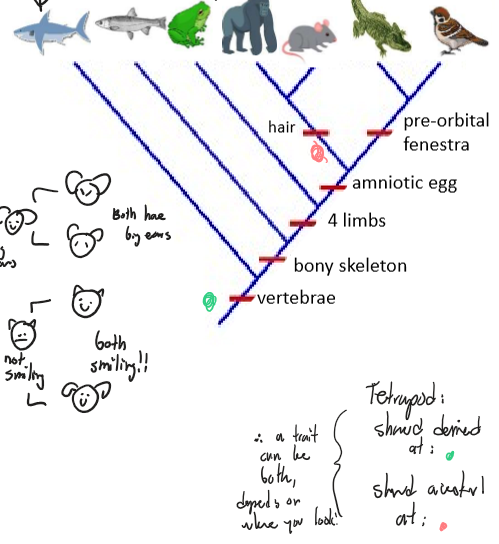Phylogeny - Lecture 1
1/25
There's no tags or description
Looks like no tags are added yet.
Name | Mastery | Learn | Test | Matching | Spaced |
|---|
No study sessions yet.
26 Terms
Taxonomy
Discipline of categorizing organisms through names
based on shared traits, not phylogenies
Shared Traits Taxonomy bases naming on
Morphology
Molecular Data (Biochemistry)
Genetics (DNA Sequences)
How to use the Binomal Naming System
Genus species
Capitalization matters!
Order of Taxonomic Levels (small → big)
Species, Genus, Family, Order, Class, Phylum, Kingdom, Domain
ex of Phylum: Chordata (Vertebrates!)
Phylogeny
The evolutionary history of a species or a group of species
never definite
Most confident means of measuring Phylogeny
DNA sequencing based on the # of deletions, insertions, and substitutions in one’s genome
Systematics
The classification of evolutionary relationships, not just naming
How Systematists Classify evolutionary relationships
Morphological Data
Genetics
Biochemical Data
EX: Myoglobin (RBC) Protein Sequence
The more similar the myoglobin (RBC) sequence, the more related two organisms are.
Branch Points
The divergence of a common ancestor into two unique species, essentially a site of speciation
can be rotated
Sister Taxa
Groups sharing an immediate taxa, said to be the most related to each other because of their close common ancestor
Outgroup
A relative term used for a species that is relatively related and similar to the ingroup, but lacks a distinct trait
“Rooted” Trees
Phylogenic Trees that have a common ancestor at the beginning that relates to the ENTIRETY of the tree!
Polytomy
A phenomenon on a phylogenic tree where a branch point leads to MORE THAN TWO organisms rather than just two
preferably, we have only 2

Rules of Constructing Phylogenies
Use morphological and molecular data
Use homologies and not analogies
Homologies
Traits of species’ that have the same structure and different function, signifying there was a common ancestor and an evolutionary relationship
Analogies
Structures with the same function, but not a common ancestor
Cladistics
The grouping of organisms into clades
Clade
A monophyletic group that includes all ancestral species plus ALL of its descendants
Paraphyletic group
Like a monophyletic group, it has a common ancestor, but not ALL of its descendants: only some
Polyphyletic
A group of species with no common ancestor (ex: Thinking whales and seals are related, so we group them, but their common ancestor is long ways away)
Shared Derived Character
A characteristic that is not in the ancestor, but in all of its descendants
more informative and definite about relationships
Shared Ancestral Character
A characteristic found in an ancestor and all of its descendants
How a character can both be Shared Derived and Shared Ancestral
Ex: Hair on Mammals
It depends on where you look on the tree

Three ways of Inferring Evolutionary Relationships
DNA, Mitochondrial DNA, or rRNA relationships
Asking live organisms about their insights
DNA Barcoding Project (stocking the entire genome of an organism!)
Why use rRNA or mitochondrial DNA over regular DNA?
There are multiple copies of rRNA and multiple mitochondria in a cell, thus there is easier isolation and more abundance to isolate